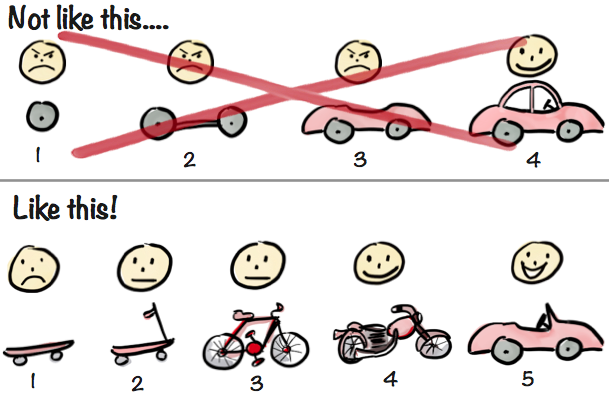The most common reason that startups fail is because there was no market need, according to a CB Insights post-mortem of more than 100 companies. Nearly half of the companies surveyed spent months or years building a product before discovering that nobody was interested in it. A minimum viable product, or MVP, is a way to avoid these scenarios and reduce risk.
Let’s take a look at how to best think about MVPs and some best practices that you can use to efficiently validate your ideas before investing heavily in them.
The best MVPs are simple rather than minimal and emphasize viability. Share on XWhat is an MVP?
ProductPlan defines a minimum viable product, or MVP, as a product with enough features to attract early customers and validate a product idea early in the product development process. Rather than building out an entire vision, MVPs validate ideas with minimal time and resources to reduce risk in case the product doesn’t succeed or there’s a need to pivot.
There are several good reasons to use MVPs:
- Release a product to market as quickly as possible.
- Test an idea with real users before committing to it.
- Learn what resonates with a target audience.
In practice, businesses tend to go through a lot of MVPs before developing a mature and stable product, which makes them more of a process than a product. With each iteration, businesses ask themselves, “what is the riskiest assumption?” and “what is the smallest experiment that I can use to test the assumption?”, and build an MVP as the experiment.
Let’s take a look at an example: Suppose that a startup wants to validate a business idea. They may create a landing page (e.g. MVP) that enables customers to preorder a product or service at a lifetime discount. If they receive enough preorders, they may build the simplest version of the product (e.g. MVP) and test user engagement to confirm their hypotheses.
Redefining the MVP
Minimum viable products can be anything from a drawing on the back of a napkin to a mobile app with a targeted set of features. While Airbnb famously built a landing page as their initial MVP, the pendulum may have swung too far to landing pages and rough-around-the-edges or incomplete products that are marketed with Google AdWords to gauge interest.

Good vs. Bad MVPs – Source: Crisp
Jason Cohen suggests that MVPs adopt SLC instead:
- Simple: A limited scope is critical to quickly delivering products.
- Complete: The product should be usable as-is to accomplish a task.
- Lovable: Customers should love using the product.
In other words, Cohen recommends building version 1.0 or something simple rather than version 0.1 of something complex. Landing pages may be appropriate for validating that an early-stage market exists, but the best MVPs deliver real value where companies can look at metrics like usage in addition to basic expressions of interest.
Slack, Twitter, Stripe and Snapchat are just a handful of companies that took a SLC-like approach by building simple products that customers loved. In fact, some would argue that the features that some of these companies have added since their expansion have made them less enjoyable or easy to use!
How to Design a Great MVP
Start with a specific hypothesis that you want to validate. For example, Spotif believed that most people would be willing to pay to stream music at a time when most people were buying CDs or pirating music online. The idea of streaming music may seem obvious now, but it was a risky assumption at the time that required an MVP to test.
Next, determine the minimum set of features needed to test the hypothesis. For instance, Spotify engineers felt that the key feature was latency since they wanted people to feel like they had access to a hard drive with the world’s music. It was the single most important feature that would prove whether customers would be willing to pay for streaming music.
When building these features, try to create something that’s simple, complete and lovable, but doesn’t necessarily need to scale. For example, Spotify engineers focused on building a low latency system that could stream a few hardcoded songs. They weren’t worried about the amount of music, artist licensing, legal agreements or other problems yet.
Finally, you can take the findings and either start building out the product a bit more or rethink the idea. After sharing the concept with friends and family, Spotify quickly learned that the technology was feasible, and people loved the product. The prototype helped them convince music labels and investors to commit to building out the full vision that it is today.
The Bottom Line
Minimum viable products, or MVPs, are designed to quickly and inexpensively test ideas, but that doesn’t mean that they shouldn’t be simple, complete and lovable. By limiting the scope to a minimal set of features, businesses can focus on doing one thing really well and affirming whether customers are willing to buy into an idea.
If you don’t take the time to build an MVP, you could risk becoming one of the 40%+ of startups that fail due to the lack of an interested customer. If you build a cheap MVP, the data quality to confirm your hypotheses may not be accurate enough, and you may end up failing anyway. Creating better MVPs is the best way to ensure that your products don’t fall flat.
If you’re looking for help building out your ideas, Sharkbyte can help provide accurate time and cost estimates, augment your existing development team with senior engineers, or even take on the entire project from start to finish. Contact us to learn more about our MVP development services and how we can assist in streamlining the development costs and process to create a successful and efficient MVP development journey for your business.



